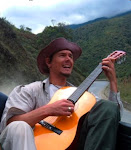Buenas,
the jungle was intense
hot, humid, loud, buggy, beautiful!
so lush, so green.
the overwhelming sensation was one of being surrounded by life.
a place where "all plants are rare and rare plants are common,"
most of the flowers were in the canopy, some 30-40 meters overhead
and between me and them was a teeming sprawl of lianas, epiphytes, aerial roots, trees shrubs and herbs. difficult to see much.
plants with spines, plants with latex,
plants that house colonies of ants in their stems, thier petioles or just on them.
small ants (3mm), big ants (1 inch) whose bite supposedly will leave you bed-ridden for 2 days, ants that taste like lemon (you have to bite them before they bite you), and army ants that eat any thing in thier path.
it was difficult to touch just about any thing without sustaining at least a couple of bites at best.
as noted in the last email there is a surprisingly large percentage (75%) of original forest left in at least the ecuadorean amazon. (although this number shrinks at an alarming rate).
the major threat to diversity is not so much to the flora (at least not yet) but to the fauna.
when roads are cut in for oil exploitation it also provides access for settlers who quickly hunt out anything worth hunting, including, cats birds, rodents and anything elso that may provide some necessary protein.
a complicated catch 22 for conservation.
access.
for oil, for food,
megafauna hunted to extinction and a 500 km long pipline moving crude to the coast for export (ecuador is too poor to run (m)any of their own refineries.)
as an interesting aside ecuador was relatively debt free before the oil "boom" of the "70s (of course at this point the crippling debt is given as a justification for further oil contracts and the situation worsens), but i digress......
the first place we were at (for a week) has escaped much of this onslaught. a function of the fact that the nearest town that is accessable by road was a two hour canoe ride, a two hour drive and then another two hour canoe ride away. a remarkable piece of undisturbed forest that is operated as a research station by the Universitad San Fransico de Quito.
a jaguar from the river, iguanas, 8 species of monkeys, caimen (aligator kind of creatures), herds of pecarries (kinda like wild pigs), snakes, insects galore and tooo many birds to count (toucans, parrots, parakeets, hawks, and the rare and sacred harpy eagle to name just a few).
as for plants, i havent sorted though all of my species lists yet but......
huge canopy trees in the chocolate family (Sterculia sp.) giant buttressed figs (Moraceae) and ciebas (Bombaceae) which apparently are not good places to sleep, not only because they offer bedding spots to jaguars, but also because they are the home of the devil (a different perspective than i got in southern mexico where the mayans believe that the cieba tree holds up the universe---a concept that doesnt seem too far fetched when you see the size of these epiphyte laden giants)
orchids, bromeliads, lots of Bignoniaceous vines and so many more that i think i need to consult my notes, which is ok, as i grow weary-----the altitude here definately takes its toll--not to mention the long day of errands and chores.
there will be more to be sure
would all of you in the northwest eat enough blackberries on my behalf to make your cheeks sweat and i promise to do the same for you with passion fruit
excitedly yours
t
Suscribirse a:
Enviar comentarios (Atom)





No hay comentarios:
Publicar un comentario